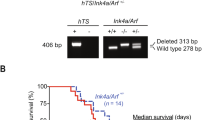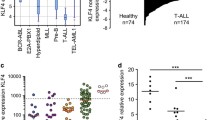Abstract
Genomic instability drives cancer progression by promoting genetic abnormalities that allow for the multi-step clonal selection of cells with growth advantages. We previously reported that the IL-9-dependent TS1 cell line sequentially acquired activating substitutions in JAK1 and JAK3 upon successive selections for growth factor independent and JAK inhibitor-resistant cells, suggestive of a defect in mutation avoidance mechanisms. In the first part of this paper, we discovered that the gene encoding mutL homolog-1 (MLH1), a key component of the DNA mismatch repair system, is silenced by promoter methylation in TS1 cells. By means of stable ectopic expression and RNA interference methods, we showed that the high frequencies of growth factor-independent and inhibitor-resistant cells with activating JAK mutations can be attributed to the absence of MLH1 expression. In the second part of this paper, we confirm the clinical relevance of our findings by showing that chronic myeloid leukemia relapses upon ABL-targeted therapy correlated with a lower expression of MLH1 messenger RNA. Interestingly, the mutational profile observed in our TS1 model, characterized by a strong predominance of T:A>C:G transitions, was identical to the one described in the literature for primitive cells derived from chronic myeloid leukemia patients. Taken together, our observations demonstrate for the first time a causal relationship between MLH1-deficiency and incidence of oncogenic point mutations in tyrosine kinases driving cell transformation and acquired resistance to kinase-targeted cancer therapies.







Similar content being viewed by others
Explore related subjects
Discover the latest articles and news from researchers in related subjects, suggested using machine learning.References
Stratton MR, Campbell PJ, Futreal PA (2009) The cancer genome. Nature 458(7239):719–724
Loeb LA (2001) A mutator phenotype in cancer. Cancer Res 61(8):3230–3239
Fox EJ, Prindle MJ, Loeb LA (2013) Do mutator mutations fuel tumorigenesis? Cancer Metastasis Rev 32(3–4):353–361
Roche-Lestienne C, Soenen-Cornu V, Grardel-Duflos N et al (2002) Several types of mutations of the Abl gene can be found in chronic myeloid leukemia patients resistant to STI571, and they can pre-exist to the onset of treatment. Blood 100(3):1014–1018
Bodmer W, Bielas JH, Beckman RA (2008) Genetic instability is not a requirement for tumor development. Cancer Res 68(10):3558–3560 (discussion 3560–3551)
Jiricny J (2006) The multifaceted mismatch-repair system. Nat Rev Mol Cell Biol 7(5):335–346
Glaab WE, Tindall KR (1997) Mutation rate at the hprt locus in human cancer cell lines with specific mismatch repair-gene defects. Carcinogenesis 18(1):1–8
Spampinato CP, Gomez RL, Galles C et al (2009) From bacteria to plants: a compendium of mismatch repair assays. Mutat Res 682(2–3):110–128
Lynch HT, Snyder CL, Shaw TG et al (2015) Milestones of Lynch syndrome: 1895–2015. Nat Rev Cancer 15(3):181–194
O’Brien V, Brown R (2006) Signalling cell cycle arrest and cell death through the MMR System. Carcinogenesis 27(4):682–692
Glaab WE, Risinger JI, Umar A et al (1998) Resistance to 6-thioguanine in mismatch repair-deficient human cancer cell lines correlates with an increase in induced mutations at the HPRT locus. Carcinogenesis 19(11):1931–1937
Ionov Y, Peinado MA, Malkhosyan S et al (1993) Ubiquitous somatic mutations in simple repeated sequences reveal a new mechanism for colonic carcinogenesis. Nature 363(6429):558–561
Herman JG, Umar A, Polyak K et al (1998) Incidence and functional consequences of hMLH1 promoter hypermethylation in colorectal carcinoma. Proc Natl Acad Sci USA 95(12):6870–6875
Simpkins SB, Bocker T, Swisher EM et al (1999) MLH1 promoter methylation and gene silencing is the primary cause of microsatellite instability in sporadic endometrial cancers. Hum Mol Genet 8(4):661–666
Hartmann A, Zanardo L, Bocker-Edmonston T et al (2002) Frequent microsatellite instability in sporadic tumors of the upper urinary tract. Cancer Res 62(23):6796–6802
Gu L, Cline-Brown B, Zhang F et al (2002) Mismatch repair deficiency in hematological malignancies with microsatellite instability. Oncogene 21(37):5758–5764
Siu LL, Chan JK, Wong KF et al (2002) Specific patterns of gene methylation in natural killer cell lymphomas: p73 is consistently involved. Am J Pathol 160(1):59–66
Matheson EC, Hall AG (2003) Assessment of mismatch repair function in leukaemic cell lines and blasts from children with acute lymphoblastic leukaemia. Carcinogenesis 24(1):31–38
Mao G, Yuan F, Absher K et al (2008) Preferential loss of mismatch repair function in refractory and relapsed acute myeloid leukemia: potential contribution to AML progression. Cell Res 18(2):281–289
Griffiths EA, Gore SD, Hooker CM et al (2010) Epigenetic differences in cytogenetically normal versus abnormal acute myeloid leukemia. Epigenetics 5(7):590–600
Hangaishi A, Ogawa S, Mitani K et al (1997) Mutations and loss of expression of a mismatch repair gene, hMLH1, in leukemia and lymphoma cell lines. Blood 89(5):1740–1747
Morimoto H, Tsukada J, Kominato Y et al (2005) Reduced expression of human mismatch repair genes in adult T-cell leukemia. Am J Hematol 78(2):100–107
Springuel L, Hornakova T, Losdyck E et al (2014) Cooperating JAK1 and JAK3 mutants increase resistance to JAK inhibitors. Blood 124(26):3924–3931
De Smet C, Lurquin C, Lethe B et al (1999) DNA methylation is the primary silencing mechanism for a set of germ line- and tumor-specific genes with a CpG-rich promoter. Mol Cell Biol 19(11):7327–7335
Uyttenhove C, Simpson RJ, Van Snick J (1988) Functional and structural characterization of P40, a mouse glycoprotein with T-cell growth factor activity. Proc Natl Acad Sci USA 85(18):6934–6938
Louahed J, Kermouni A, Van Snick J et al (1995) IL-9 induces expression of granzymes and high-affinity IgE receptor in murine T helper clones. J Immunol 154(10):5061–5070
Bergmann AK, Schneppenheim S, Seifert M et al (2014) Recurrent mutation of JAK3 in T-cell prolymphocytic leukemia. Genes Chromosomes Cancer 53(4):309–316
Kiel MJ, Velusamy T, Rolland D et al (2014) Integrated genomic sequencing reveals mutational landscape of T-cell prolymphocytic leukemia. Blood 124(9):1460–1472
Lynch M (2010) Rate, molecular spectrum, and consequences of human mutation. Proc Natl Acad Sci USA 107(3):961–968
Lee H, Popodi E, Tang H et al (2012) Rate and molecular spectrum of spontaneous mutations in the bacterium Escherichia coli as determined by whole-genome sequencing. Proc Natl Acad Sci USA 109(41):E2774–E2783
Long H, Sung W, Miller SF et al (2014) Mutation rate, spectrum, topology, and context-dependency in the DNA mismatch repair-deficient Pseudomonas fluorescens ATCC948. Genome Biol Evol 7(1):262–271
Jiang X, Saw KM, Eaves A et al (2007) Instability of BCR-ABL gene in primary and cultured chronic myeloid leukemia stem cells. J Natl Cancer Inst 99(9):680–693
Grant H, Jiang X, Stebbing J et al (2010) Analysis of BCR-ABL1 tyrosine kinase domain mutational spectra in primitive chronic myeloid leukemia cells suggests a unique mutator phenotype. Leukemia 24(10):1817–1821
Iqbal Z, Aleem A, Iqbal M et al (2013) Sensitive detection of pre-existing BCR-ABL kinase domain mutations in CD34+ cells of newly diagnosed chronic-phase chronic myeloid leukemia patients is associated with imatinib resistance: implications in the post-imatinib era. PLoS One 8(2):e55717
Bolton-Gillespie E, Schemionek M, Klein HU et al (2013) Genomic instability may originate from imatinib-refractory chronic myeloid leukemia stem cells. Blood 121(20):4175–4183
Perrotti D, Jamieson C, Goldman J et al (2010) Chronic myeloid leukemia: mechanisms of blastic transformation. J Clin Invest 120(7):2254–2264
Burke BA, Carroll M (2010) BCR-ABL: a multi-faceted promoter of DNA mutation in chronic myelogeneous leukemia. Leukemia 24(6):1105–1112
Kim JH, Chu SC, Gramlich JL et al (2005) Activation of the PI3K/mTOR pathway by BCR-ABL contributes to increased production of reactive oxygen species. Blood 105(4):1717–1723
Koptyra M, Falinski R, Nowicki MO et al (2006) BCR/ABL kinase induces self-mutagenesis via reactive oxygen species to encode imatinib resistance. Blood 108(1):319–327
Sattler M, Verma S, Shrikhande G et al (2000) The BCR/ABL tyrosine kinase induces production of reactive oxygen species in hematopoietic cells. J Biol Chem 275(32):24273–24278
Stoklosa T, Poplawski T, Koptyra M et al (2008) BCR/ABL inhibits mismatch repair to protect from apoptosis and induce point mutations. Cancer Res 68(8):2576–2580
Cortes J, Jabbour E, Kantarjian H et al (2007) Dynamics of BCR-ABL kinase domain mutations in chronic myeloid leukemia after sequential treatment with multiple tyrosine kinase inhibitors. Blood 110(12):4005–4011
Shah NP, Skaggs BJ, Branford S et al (2007) Sequential ABL kinase inhibitor therapy selects for compound drug-resistant BCR-ABL mutations with altered oncogenic potency. J Clin Invest 117(9):2562–2569
Soverini S, Gnani A, Colarossi S et al (2009) Philadelphia-positive patients who already harbor imatinib-resistant Bcr-Abl kinase domain mutations have a higher likelihood of developing additional mutations associated with resistance to second- or third-line tyrosine kinase inhibitors. Blood 114(10):2168–2171
Acknowledgments
This work was supported in part by the Belgian Program on Interuniversity Poles of Attraction initiated by the Belgian State, Prime Minister’s Office, Science Policy Programming (Grant IAP-P7/39 to J.C.R.), by the Actions de Recherche Concertées of the Communauté Française de Belgique (Grant ARC09/14-021 to J.C.R.), by the Fondation contre le Cancer, by the Foundation Salus Sanguinis, Belgium, and by the Fonds pour la formation à la Recherche dans l’Industrie et dans l’Agriculture (F.R.I.A). E.L. is the recipient of a fellowship from FRS-FNRS Télévie. L.K. is a MD fellow of the Fonds National de la Recherche Scientifique (F.N.R.S.), Belgium.
Author information
Authors and Affiliations
Corresponding authors
Ethics declarations
Conflict of interest
The authors declare that they have no conflicts of interest with the contents of this article.
Additional information
L. Knoops and J.-C. Renauld shared senior co-authorship.
Electronic supplementary material
Below is the link to the electronic supplementary material.
Rights and permissions
About this article
Cite this article
Springuel, L., Losdyck, E., Saussoy, P. et al. Loss of mutL homolog-1 (MLH1) expression promotes acquisition of oncogenic and inhibitor-resistant point mutations in tyrosine kinases. Cell. Mol. Life Sci. 73, 4739–4748 (2016). https://doi.org/10.1007/s00018-016-2310-2
Received:
Revised:
Accepted:
Published:
Issue Date:
DOI: https://doi.org/10.1007/s00018-016-2310-2




